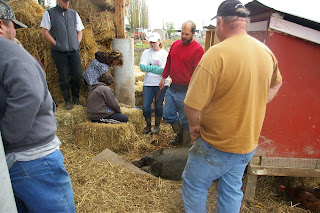 This woman let her dog out of the dog park without a leash. the dog ran across the road to my pasture fence and scared the sheep and turkeys inside that fence away from the fence. The dog then ran down my fence, through my gate and started chasing the turkeys it found about 100' down my driveway. The woman didn't attempt to pursue the dog at all. The dog was tearing feathers off the turkeys and the main reason that it didn't kill any of them was that it couldn't figure out which one it wanted to start with.
This woman let her dog out of the dog park without a leash. the dog ran across the road to my pasture fence and scared the sheep and turkeys inside that fence away from the fence. The dog then ran down my fence, through my gate and started chasing the turkeys it found about 100' down my driveway. The woman didn't attempt to pursue the dog at all. The dog was tearing feathers off the turkeys and the main reason that it didn't kill any of them was that it couldn't figure out which one it wanted to start with. I grabbed my rifle, stood on a pile of logs and took aim at the dog attacking my livestock. I fired a shot into the ground close to it, and it froze when it heard the gunshot. If the dog had not stopped the attack the second shot would have been into its head.
I took a couple of steps closer to the dog with the intent of grabbing it and it started after the turkeys again. A second shot got it to stop again, and it took another shot for me to get close enough to the dog to grab it by the collar, about an acre or so into my property.
Rifle in one hand and dog in the other, I met the dogs owner 25' inside my gate. "I'm sorry that my dog got out of the fence". "lady, the only reason I didn't shoot your dog today was that it stopped attacking when I fired near it. It would have been easier to shoot it and let you remove the dead dog. Keep your dog on a leash until you're INSIDE the dog park, and put it on a leash before you leave the dog park. This is an agricultural area. Respect that. "
I talked to Chris Newman, who is running the dog park, and explained I'd had another dog related incident. This is the 6th one. "Bruce, I've told people to keep their dogs on lease, I'd support you if you shot one". I've asked him to put a better fence up on his side, but he thinks that the current dog park fence is enough.
I don't think that most folks who take their dogs to an offleash area consider they may lose their dog as a result. I don't like being the bad guy here, but I've done about all I can do. I've been clear, I've spent $4,000 on fencing, and I've lost livestock.
Maybe I should just start shooting them.






















































